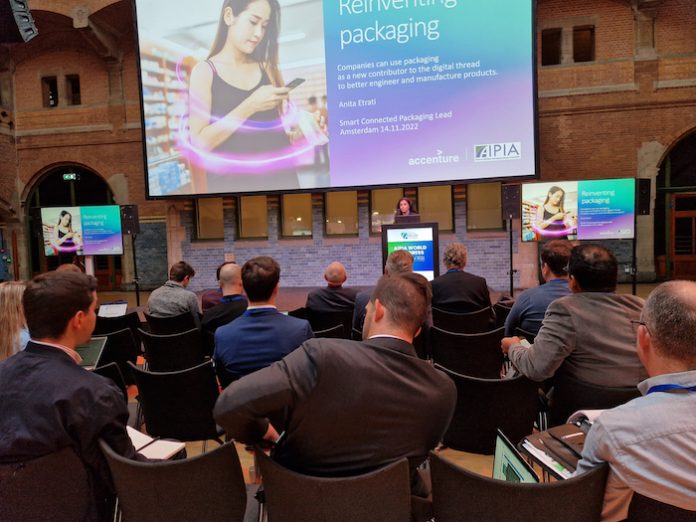The first live AIPIA World Congress since 2019 took place in Amsterdam on 14 and 15 November 2022, and the delegates, presenters, and exhibitors all agreed that it was great to finally get back to face-to-face business. The 2022 Congress, although smaller in size, seemed to have lost none of the dynamic the event is famous for. In the notably disruptive sector of packaging the ‘creative chaos’ that has been an AIPIA hallmark, was clearly in evidence. And with more than 30 presentations ranging across every aspect of Smart Packaging, there were many technologies and ideas to catch up on.
Themes
Several themes emerged from the two days, notably the need to share and act upon the data that smart packaging enables brands and retailers to collect about consumers and products. In one of the first keynote presentations, Anita Etrati of Accenture explained how a convergence of smart and connected technologies is transforming humble packaging into a new source of real value and how this needs to be acted upon with more vigor.
Of course, the role Smart Packaging has to play in sustainability was a prominent conversation. Several presentations covered how these technologies are an enabler and an educator about, for example, the collection and recycling of different types of packaging. Guido Schmitz of InnCreReal (and formerly of Bayer) is a vocal advocate of the important place Smart Packaging has in this area. He believes sustainability is front and center, “It is no longer just a topic for most companies but a demand.”
Data
The importance of data was reinforced by several other speakers, notably in a panel discussion that included several brand owners, including AB InBev and J&J. The panel emphasized that smart packaging opens a new dimension to the collection and delivery of data. This data flows two ways, outwards to suppliers, retailers, and customers and internally to improve production, distribution, marketing, and even new product development (NPD). Being able to interpret this stream of data is vital. All stakeholders in the supply chain need to change their way of thinking about how to handle data, to ensure it is shared across all parts of the business.
Another theme was the growing importance of Active Packaging as a means to reduce food waste and improve a product’s environmental footprint. Opening the congress Angela Morgan of Aptar told delegates that while packaging has always been a help in reducing food waste, now active and intelligent packaging technologies are offering new options to reduce this waste. Several other speakers developed this theme. Danny Hacohen of Evigence Sensors offered use cases showing that sensors can measure freshness objectively, enabling shelf life extension, leading to waste reduction, improving consumer perception of freshness, and simplifying store inventory management.
Consumer education
One of the most important discussions centered around how consumers can be educated to better understand the benefits of Smart Packaging and how it is easy for them to connect to it. Several speakers demonstrated consumer-friendly technologies, for example, Martin Stahel of Zappar, as usual, brought the first-day proceedings to a rousing climax with more examples of how Augmented Reality is being used to both entertain and inform consumers about the products they buy. He showed how the solution has evolved both in terms of what the tech can deliver and how brands are using AR to generate commercial value.
Of course, connected supply chains were a recurring topic throughout the Congress. Another panel, including representatives of Kezzler, GS1, and Accenture explored how to build sustainable value chains, which require end-to-end visibility across the supply chain. They asked how can this transparently be achieved and shared. They explained that traceability technology underpins this visibility and insight – enabling the circular economy, meeting consumer demands, and achieving regulatory compliance.
Brand Challenge
No AIPIA Congress is complete without a Brand Challenge and the 2022 event was no exception. This year the GSK spin-off Haleon, which is responsible for famous brands such as Sensodyne toothpaste, Otrivin respiratory treatment, Advil pain relievers, and Centrum supplements, challenged twelve AIPIA companies to show how it can integrate active and intelligent packaging to enhance the consumer experience, provide traceability, enhance safety and or security, as well as extending shelf-life or reducing waste.
After an action-packed hour, where each company is given precisely 4 minutes to pitch its ideas the three selected for further investigation were Securikett, with its suite of tamper-evident brand protection and security labels and associated cloud platform Codikett; Alma Science’s paper electronics for connected packaging which proposed to use its paper action buttons technology in order to turn the packaging of Centrum Junior Vitamins into a game controller; and Ennoventure’s invisible encryption technology, used for brand protection, tracking and tracing and to enhance brand engagement. But lead judge Anu Gadhiraju from Haleon said other ideas were also worthy of further consideration.
In the hall, Ondrej Panák R&D associate at MyCol introduced a range of irreversible thermochromic labels that allow simple visual indication if the temperature gets over a certain threshold. This threshold can be adjusted according to the product, so from freezing to high temperatures. Labels change color from white and, thanks to its unique technology MyCol says it offers customizable designs, a variety of color options, and different label materials.
Paper-based
A stalwart of the Congress Securikett introduced the IT’s PAPER-based security labels and tapes series. These can be recycled together with the paper or cardboard packaging to optimize the paper recycling process, says the company. These paper-based security labels can be customized in color, size, shape, and design and Securikett says it can create both opaque as well as translucent versions. Combined with a unique QR code, products can easily be digitalized.

Photo AIPIA
Meanwhile, Systech showed its latest digital supply chain technologies which are helping several Fortune 500 companies to give their products individual identities. These connected products enable a connected, more agile supply chain. Tessa Eastman, the connected products strategist for the company, offered specific use cases which have helped companies to create transparency across their supply chains, reducing risk, offering consumer protection, and meeting regulatory demands.
Supply chains
Supply chains were a key feature of several presentations. Thaddeus Segura, VP of data products and algorithms for Wiliot, claimed that smart packaging plus Ambient IoT is a ‘giant fix’ for supply chains. Fully scaled, Massive IoT will mean that everything can be internet-connected, making smart packaging truly smart. He claims that the fundamental breakthrough – Wiliot’s stamp-sized IoT Pixels, actual programmable computers – will transform global supply chains, creating never-before-possible efficiencies that will reach deeply into industries, ranging from food to pharma to apparel.
Digital Codes
Gary Parish, managing director of USA-based HD Barcode LLC explained that the advances in digital printing and smartphone camera technology mean a seemingly simple 2D code can be provided as an HD MultiCode with up to four individual codes together, to provide both manufacturers’ and consumers, public and secure – private information. This enables the codes to provide brand protection to prevent anti-counterfeiting with or without the Internet; track & trace information that prevents diversion, as well as identifying other unique anti-counterfeit features. In addition, it allows consumers to read a public QR code from their smartphone for authentication, while an optional fourth code can provide directions for use or ingredients that can be read in any language.
In a rousing ‘Call to Action’ Robson Lisboa, CEO of Midiacode challenged brand owners to implement smart packaging at scale across all their products, not just for pilot projects or targeted campaigns. He feels the time is right to offer smart packaging as a standard. But when asked by the audience how that can be achieved at an affordable price and how to do it without letting marketing and packaging teams go crazy with endless work he had an answer! He believes simple connectivity via QR codes – which he says are set to boom – is the answer and offered a highly upbeat vision of the future and use cases across a range of applications. Watch this space!
Digital Product Passports
There was much talk about Digital Product Passports (DPP). In a presentation on this ‘hot’ topic, Monica Gross, ecosystem engagement manager of Food & Beverage for Avery Dennison, and her colleague Noam Assael, director of business ventures, at AD, outlined the reasoning behind the creation of these. DPP is designed to make it easier to repair or recycle products and track substances of concern along the supply chain. According to the European Commission proposal, all regulated products sold in Europe will need to have a DPP within the next couple of years.
They explained just what is meant by a connected digital item-level product; how the digitization of the supply chain can provide the transparency, circularity, and provenance needed to comply with DPP, as well as how organizations can prepare for this new regulation and which tools and methods need to be implemented. There are several benefits DPP could bring to consumers beyond the information currently found on websites, they say, but challenges remain to make DPPs happen and they strongly advised collaboration across the supply chain.
A further panel discussion on DPPs, featuring Per Christian Myklebost, Johan Borg, and John Beerens all from Kezzler, as well as contributors from Accenture and GS1, went further, explaining that these passports are designed to support sustainability and circular goals. Soon they will be required to sell products in specific categories (starting with apparel and textiles) within the European Union. They highlighted the critical elements to consider when choosing a traceability platform, the importance of interoperability and technology standards, and the benefits of end-to-end traceability beyond regulatory compliance in creating sustainable value chains.
NFC Challenge
In one of the final presentations of the day Justina Karpavice, a PhD Fellow at Aarhus University laid down a challenge to the sector. Having undertaken research on NFC-enabled product packaging she said that, despite all the significant capabilities of NFC, the technology is still not as widely accepted by consumers, retailers, or manufacturers as it should be. Various challenges related to technological feasibility, customer acceptance, and economic benefit for businesses hinder NFC technology from being more widely applied in packaging. The main aim of her research, which is ongoing, is to carry out experiments to examine the peculiarities of the user interaction of NFC-enabled packaging which could lead to more comprehensive insights regarding its potential implementation. She urged the industry to work together with academia to overcome these obstacles.
Closing
Closing the Congress for 2022 AIPIA’s managing director Eef de Ferrante summed up his view of the event, “It is clear that our members and stakeholders welcomed the return of a live event and the ability to have in-depth discussions with real people. There is still a lot of work to do to build back both the Congress and the momentum of the smart packaging sector. While we never lost the innovative energy, the pandemic did put a brake on both new product development and implementation. As l always maintain, we are building this industry together. It’s been a great start, there is still much to do. See you all in 2023!”
This article is republished by permission of the author and the AIPIA.










